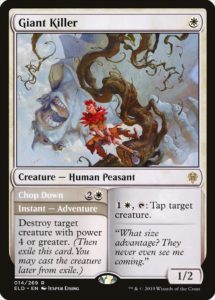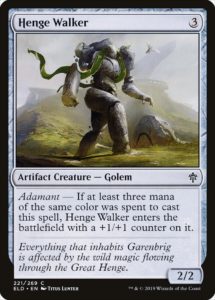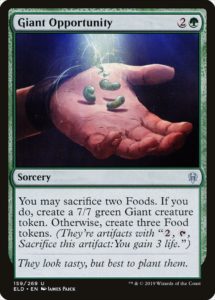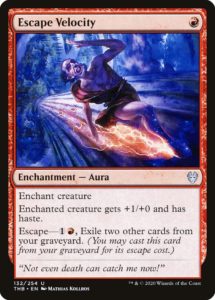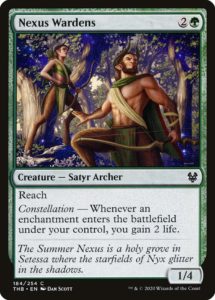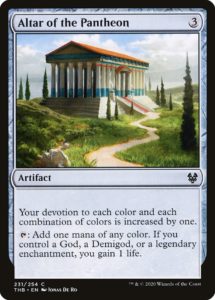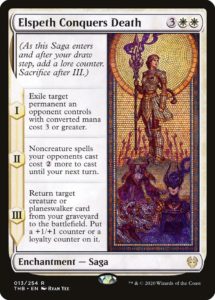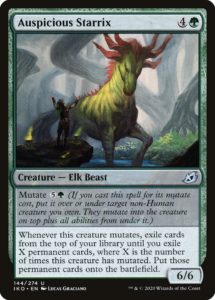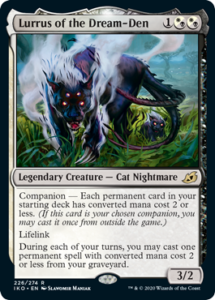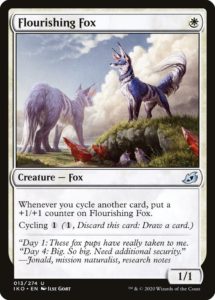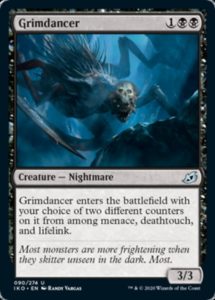Magic’s State of Design comes out next week, giving us an opportunity to reflect on another year of designs and mechanics. Today, we’ll look back on all the major mechanics from the past year.
Major Mechanics
Adventure
Adventure is beautifully innovative, using familiar components in familiar ways to create something cohesive, simple, and utterly new. It employs Split card technology, using it to cleave enters-the-battlefield effects off of creatures and create two (often synergistic or thematically connected) spells. It plays like an inverted Evoke, where the creature is guaranteed but the spell requires a premium. It shows a different way of telling stories with creatures than double faced cards, where instead of showing a moment of transformation it features an act the creature is capable of.
There may not be be a super deep design well of Adventure spells thematically or synergistically connected with their creatures (compare Queen of Ice with Bonecrusher Giant), and it would likely be difficult to tell many such stories outside of top-down designed worlds. However, the overall design space of Adventure is likely as deep as creatures with ETB effects; the combination of the two components allows for niche spells and creatures to shrine (Faerie Guidemother is excellent despite the mediocrity of its constituent parts). Adventure seems a solid mechanic and one I hope to see before the likely return to Eldraine. Who knows? Perhaps it’d even make sense when we return to Zendikar, the Adventure World.
Grade: A (Looking forward to seeing it again soon)
Adamant
Adamant is a workhorse mechanic. It’s not particularly eye-catching or Constructed-relevant, but it does fine work. Adamant hearkens back to the two-brid cards of Shadowmoor (such as Beseech the Queen), but provides a benefit instead of a cost reduction. The mechanic provided a very unusual tension in Limited where players were strongly encouraged to play monocolor or heavily skewed two color manabases. In large amounts, Adamant would constrain any format to be too focused on monocolor play (an issue Eldraine suffered from, though that’s not all Adamant’s fault), but in moderation, this is a fine mechanic.
Grade: B- (Interesting tension, best in moderation)
Food
Food joins Treasures and Clues as the third major artifact token (sorry Gold). Its effect is less explosive than Treasures’ mana ramp and less advantageous than Clues’ cantripping, but Food being weaker than its forebears isn’t a knock against the mechanic. Indeed it found a different niche as an alternate resource mechanic, regularly being converted into other effects.
On its own, Food is a lose-slower mechanic which promotes the problematic pattern of slowing games down. Still, the Limited environment compensated by having incredibly potent monocolor aggro decks. Food clearly didn’t suffer in Constructed thanks to cards like Oko, Thief of Crowns or Cauldron Familiar.
Grade: B (Fine mechanic, would prefer to see something new or Clues again before seeing Food return)
Escape
Escape might have the best Limited play pattern of any recursive mechanic ever. Unlike many graveyard mechanics that are watered down in Limited to not break Constructed, Escape was relevant in both. Escape combined the recursive patterns of Dredge with the fuel of Delve, two of Magic’s most dangerous mechanics and yet managed to work swimmingly. Even the awkward fact that every Escape creature returned with different stats was surprisingly easy to remember.
Despite some early reservations, Escape was an outstanding mechanic. Its biggest issue was likely being spread too unevenly—white and blue had no common Escape creatures. It’s truly impressive that a twist on Buyback with a kinder restriction than Retrace played as well as it did.
Grade: A (Sometimes being wrong is awesome)
Constellation
One of the biggest complains the first time we visited Theros was the meager amount of enchantment-matters. Constellation being intentionally held in reserve until Journey Into Nyx might have been the biggest issue with original Theros block, so Wizards made sure to bring it back in Theros Beyond Death.
The THB innovation was a simple one—where once Constellation was exclusively on enchantments, now it is exclusively on nonenchantment creatures. This weakened the mechanic but created a more interesting deckbuilding puzzle—finding the optimal balance between enchantments and Constellation payoffs rather than just playing as an all-enchantment deck. A fine twist, but not a major innovation. With constellation restricted mostly to heavy white and green-blue decks, it was more of a mini-theme than a major one and was less memorable as a consequence.
Grade: C+ (Fine execution, but fine isn’t exciting)
Devotion
Devotion beautifully nestles the resonance of faith within Magic’s color pie. It’s likely the best example of a rehabilitated mechanic (née Chroma) and was a shoo-in to return with Theros. It is mostly used in familiar, sometimes extremely familiar ways—see Reverent Hoplite, Evangel of Heliod, Setessan Petitioner, Nylea’s Disciple. But there were new innovations such as the demigod cycle (which set power/toughness equal to your devotion) and Altar of the Pantheon appropriately increasing all belief.
Devotion was sprinkled throughout the set, generally at higher rarities, so it was less relevant in Limited while being format-defining in Constructed (Thassa’s Oracle, Anax, Hardened in the Forge). In general, I think Theros erred by having far too many mechanics and diluting each of them to compensate. While Devotion fared best of all returning mechanics, it gets dinged a tad by this.
Grade: B+ (Excellent mechanic, fine execution if a bit familiar)
Saga
The beloved Dominaria mechanic (based on the initial Planeswalker design) returns, this time telling stories that fuse Magic lore with Greek mythology. Theros is an ideal world for Sagas, since it’s both brimming with real world mythology and enchantments are more relevant there than anywhere else. There were only two innovations since Dominaria—adding a fourth chapter and The Triumph of Anax using lore counters to upscale an effect. However, minimal innovation is an especially unfair criticism of sagas given that every one of them tells a unique story using synergistic yet disparate components. I look forward to seeing them return on another world or in an Origins-style set where they can recount major events on worlds that likely couldn’t support 10+ sagas.
Grade: A- (Solid mechanic, would listen again)
Mutate
Mutate resembles Bestow, but where Bestow presented an obvious play pattern (it’s safe and always advantageous to Bestow), Mutate presented puzzles: when is having a second creature better than building a single, better, and riskier creature? When is going all-in on Mutate triggers worth doing? Mutate played surprisingly well in a format where high-quality removal like Blood Curdle threatened to make Mutation a losing proposition.
Mutate has several issues. It is complicated. Sure, it might play well once you finally understand it, but it takes time to understand. It doesn’t work with humans, increasing and decreasing the power of every creature based on its type. I understand that Innistrad is the world where humans transform into monsters, but this additional, forgettable restriction might not have been worth tacking on to an already overstuffed mechanic. Mutate is a cool, innovative, and unusual mechanic we’re likely not to see until we return to Ikoria, though I can imagine cool things happen if Phyrexians get involved.
Grade: B- (Exciting potential, unfortunate complexity)
Companion
Companion is one of the boldest mechanical experiments Magic has undertaken in recent memory. It is also one of the most problematic mechanics ever created; it received power level errata before Ikoria was two months old, the first time a mechanic had ever been so revised.
There are two ways to evaluate Companion: the restriction and the payoff. Companion’s restriction presents exciting deckbuilding puzzles, especially in Limited. Each Companion is effectively its own draft archetype (except for Jegantha, the Wellspring, which was facile to enable) and does kooky things to pick orders. I won’t forget what it was like to try and make Keruga, the Macrosage work or how hilarious drafting with Lurrus of the Dream-Den was. Companion was absolutely a successful mechanic when considering the fun of meeting its restrictions.
The problem is the payoff. As we all know by now, having a guaranteed card in your starting hand is enormous, and that’s before acknowledging how strong every Companion in its own right or that Companion also provides card advantage. While some Companion restrictions are a challenge in Limited, the most powerful Companions are far easier to enable in Constructed (and while it was fun playing with a Companion in draft, it got boring playing against Companions every single game).
There’s a real question about whether Companion should have ever been made at all—given how powerful guaranteed cards are, was it possible to develop Companions powerful enough to justify contorting a deck around without breaking the game? I’m not certain if the developmental issues stemmed from Vision Design (as was the case with Energy) or if they could have been ironed out in Set or Play Design, but the end result was a major problem. While it’s absolutely vital for Magic to experiment, even though treading into the unknown risks mechanics both broken mechanics and underwhelming, Companion proved a damaging, deeply flawed mechanic.
Grade: B- (Restriction)
Grade: D- (Execution)
Cycling
Cycling is one of Magic’s best card flow mechanics. It helps you find lands, play a higher threat density and more reactive cards than normal, and spend your mana more reliably. It’s Magic’s most prolific mechanic that was never evergreen or deciduous, showing up in Urza’s Saga, Onslaught, Time Spiral, Shards of Alara, and Amonkhet blocks. A consequence of its long history is that Ikoria had little room to innovate. It smartly employed Ikoria-specific ability counters on cards like Titanoth Rex, but the most notable change to Cycling was its cost reduction.
Cycling initially always cost 2 generic mana. In Onslaught, it sometimes cost a single pip of mana (and sometimes cost far more). Ikoria introduced 1 generic mana Cycling costs. This made some sense—players were getting more power for their mana in 2020 than they were in ’97, especially with creatures, so why not improve Cycling? If you’ve played much Ikoria Limited, you’ve witnessed what happens when you can fill your deck with effortless cantrips. The RW Cycling deck was hilarious and overpowered, managing to be incredibly consistent, incredibly threat-dense (usually playing ~13 lands and 27 spells), and nearly impossible to interact with—especially in conjunction with Zenith Flare (a card that should have been rare or unable to hit players).
It was usually correct to pick a one-mana Cycler, even an off-color one you could never cast, simply because of how powerful the Cycling payoffs were and how low the opportunity cost was (since you were usually cutting lands to make room for Cyclers, not spells). The overall effect of one-mana Cycling was to dramatically unbalance the format until people realized that taking exciting spells over uncastable Cyclers was wrong, a problem that would never have happened if one-mana Cyclers required colored mana.
Grade: D (Outstanding concept, super problematic execution. Really fun deck to play, miserably consistent deck to play against.)
Keyword counters
Where Mutate was complicated, keyword counters were simple. Just as +1/+1 counters increase power and toughness, and Arcane Flight provides Flying, so too does a Vigilance counter provide Vigilance. My biggest question mark—how easy it is to track this information with punch out tokens—is still outstanding, since I haven’t played a paper game against another person since March. But playing with Ikoria online, it was generally memorable when a creature gained an ability (except for Blood Curdle, when the focus was solely on the creature destruction). I can imagine keyword counters returning another day, perhaps in smaller number (and without punch out technology), or not seeing them again until we return to Ikoria.
Grade: B (simple and clean, but a bit fiddly and probably problematic in higher volume)
And that’s every major mechanic of the past year. We’ll have to save the most notable minor ones for another time, but for now, it’s time to call it a day and wait to see what Mark Rosewater has to say about the year (and for sure Companions) next week.
Until then, and as always, thanks for reading.
—Zachary Barash is a New York City-based game designer and the commissioner of Team Draft League. He designs for Kingdom Death: Monster, has a Game Design MFA from the NYU Game Center, and does freelance gatame design. When the stars align, he streams Magic (but the stars align way less often than he’d like).

